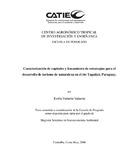Caracterización de capitales y lineamiento de estrategias para el desarrollo de turismo de naturaleza en el Río Tagatiyá, Paraguay

Voir/
Date
2008Auteur
Valiente Valiente, Emilio
Type
Tesis de maestría
Metadata
Afficher la notice complèteAlternative title
Characterization of capitals and guide lining strategies for the development of nature tourism in the Tagatiyá river, Paraguay
Description
Tesis (Mag. Sc.) -- CATIE, 2008
Résumé
En esta investigación se indaga, con el Marco de Capitales de la Comunidad (MCC), las condiciones socioeconómicas y ambientales entorno al río Tagatiyá, su aprovechamiento actual y potencial. Los resultados obtenidos revelan que el Tagatiyá ofrece importantes y valiosos recursos para el desarrollo de turismo de naturaleza. En el índice de diversidad turística (2,38), la variable transparencia del agua, abona un peso específico muy alto. Seguido por el alto porcentaje de ecosistema natural endémico de la eco-región (67 por ciento de bosque y pradera nativa en la cuenca) y otros factores relacionados. Sin embargo, hay una creciente presión de cambio del ecosistema, que amenaza la estabilidad de los recursos naturales de la zona. Esta tendencia de cambio depredativo se atribuye al auge del mercado de la madera y de la carne, que en un sistema político caracterizado por un marco normativo deficiente para el cumplimiento de leyes ambientales. El turismo de naturaleza es una estrategia y una opción válida y oportuna para el desarrollo sustentable de la zona del Tagatiyá, basado en el capital natural. Los actores interesados (capital social y financiero) y otras riquezas (capital cultural), así como la rica experiencia del Bonito MON. Sin embargo, y a pesar del potencial turístico, las actividades principales en la zona del río son la Ganadería extensiva y la forestal. Esta última actividad desarrollada de forma insostenible. En las actuales condiciones de explotación, se estiman unos 8 años más de actividad forestal extractiva en la zona. This research was conducted using the Community Capitals Framework, the socio-economic and environmental conditions surrounding the Tagatiyá river, its current use and potential. The results showed that the Tagatiyá river offers important and valuable resources for the development of nature tourism. In the index of tourism diversity (2.38), the water transparency variable has a very high specific weight followed by the high percentage of endemic natural ecosystem in the eco-region (67 percent of native forest and natural prairie) and other related factors. However, there is a growing change pressure in the ecosystem which threatens the stability of the natural resources in the area. This trend of depredated change is attributed to the booming market for wood and beef in a political system characterized by a weak regulatory framework for the compliance of environmental laws. Nature tourism is a strategy and a valid option for sustainable development in the Tagatiyá area based on the natural capital, the actors involved (social and financial capital) and other richnesses (cultural capital), as well as the rich experience in the Brazilian Bonito MON. Nevertheless, despite the touristic potential, the main activities in the river area are still extensive livestock farming and forestry. This last activity developed in an unsustainable manner. Considering the current operating conditions, it was estimated approximately eight more years of extractive forest activity (timber) in the area.
Keywords
Asesor
Gutiérrez, Isabel
Éditeur
Centro Agronómico Tropical de Investigación y Enseñanza (CATIE)
Is part of
Maestría en Socioeconomía Ambiental
Collections
- Tesis [3083]

